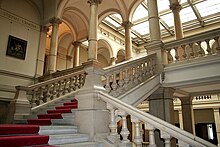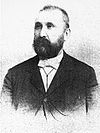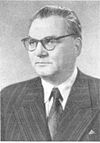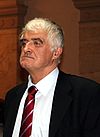 The decorated facade of the Academy Palace, Zrinski Square in Zagreb The decorated facade of the Academy Palace, Zrinski Square in Zagreb | |
| Abbreviation | HAZU |
|---|---|
| Formation | 1866; 159 years ago (1866) |
| Type | National academy |
| Purpose | Science, arts, academics |
| Headquarters | Zagreb, Croatia |
| Location | |
| Membership | 134 full members (as of November 2020) |
| Chairman | Velimir Neidhardt |
| Main organ | Presidency of the Academy |
| Budget | HRK 68.3 million (€9.1 million) (2016) |
| Website | www |
The Croatian Academy of Sciences and Arts (Latin: Academia Scientiarum et Artium Croatica; Croatian: Hrvatska akademija znanosti i umjetnosti, HAZU) is the national academy of Croatia.
HAZU was founded under the patronage of the Croatian bishop Josip Juraj Strossmayer under the name Yugoslav Academy of Sciences and Arts (Serbo-Croatian: Jugoslavenska akademija znanosti i umjetnosti, JAZU) since its founder wanted to make it the central scientific and artistic institution of all South Slavs. Today, its main goals are encouraging and organizing scientific work, applying the achieved results, developing of artistic and cultural activities, carrying about the Croatian cultural heritage and its affirmation in the world, publishing the results of scientific research and artistic creativity and giving suggestions and opinions for the advancement of science and art in areas of particular importance to Croatia.
The academy is divided into nine classes; social sciences, mathematical, physical and chemical sciences, natural sciences, medical sciences, philological sciences, Literature, Fine Arts, Musical Arts and Musicology, technical sciences. The academy started in 1866 with 16 full members which grew to today's 160. Besides full, members can also be honorary, corresponding or associate.
History
The institution was founded in Zagreb on 29 April 1861 by the decision of the Croatian Parliament (Sabor) as the Yugoslav Academy of Sciences and Arts. The bishop and benefactor Josip Juraj Strossmayer, a prominent advocate of higher education during the 19th century Croatian national romanticism, set up a trust fund for this purpose and in 1860 submitted a large donation to the then viceroy (ban) of Croatia Josip Šokčević for the cause of being able to
bring together the best minds [...] and find a way in which books in the national languages could be produced in the Slavic South; the Academy should also take under its aegis all the areas of human science

After some years of deliberations by the Croatian Parliament and the emperor Franz Joseph, it was finally sanctioned by law in 1866. The official sponsor was Josip Juraj Strossmayer, while the first chairman of the academy was the distinguished Croatian historian Franjo Rački. Serbian linguist Đuro Daničić was elected secretary general of the academy, where he played a key role in preparing the academy's dictionary, the Croatian or Serbian Dictionary of JAZU.
The academy's creation was the logical extension of the University of Zagreb, the institution initially created in 1669 and also renewed by bishop Strossmayer in 1874. Bishop Strossmayer also initiated the building of the Academy Palace in the Zrinjevac park of Zagreb, and the Palace was completed in 1880. In 1884, the palace also became a host of the Strossmayer Gallery of Old Masters that contained 256 works of art (mostly paintings). The same is today one of the most prominent art galleries in Zagreb.
The academy started publishing the academic journal Rad in 1867. In 1882, each of the individual scientific classes of the academy started printing their own journals. In 1887, the academy published the first "Ljetopis" as a year book, as well as several other publications in history and ethnology.
Vatroslav Jagić, Baltazar Bogišić, Nikola Tesla, Mihailo Petrović, Dragutin Gorjanović-Kramberger, Andrija Mohorovičić, Ivan Meštrović, Lavoslav Ružička, Vladimir Prelog, Ivo Andrić, Miroslav Krleža, Ivan Supek and Franjo Tuđman were JAZU/HAZU members.
Name changes
The academy briefly changed name from "Yugoslav" to "Croatian" between 1941 and 1945 during the Axis client regime of the Independent State of Croatia.
It has again been renamed "Croatian" in 1991 after Croatia gained independence from Yugoslavia.
Departments

The academy is divided into nine departments (classes):
- Department of Social Sciences
- Department of Mathematical, Physical and Chemical Sciences
- Department of Natural Sciences
- Department of Medical Sciences
- Department of Philological Sciences
- Department of Literature
- Department of Fine Arts
- Department of Music and Musicology
- Department of Technical Sciences
The Institute for Historical Sciences
One of the research units of the academy is the Institute for Historical Sciences. It is located in a Renaissance villa in Dubrovnik, and holds a rich manuscript and library collection. Two peer-reviewed journals are published by the institute, which are fully available online: Anali in Croatian and Dubrovnik Annals in English.
The institute for Ornithology
The Institute for Ornithology houses the Croatian bird ringing scheme, and is a member of the European Union for Bird Ringing (EURING).
Membership
See also: List of members of the Croatian Academy of Sciences and ArtsThere are four classes of members:
- Full members
- Associate members
- Honorary members
- Corresponding members
The number of full members and corresponding members is limited to 160 each, while the maximum number of associate members is 100. Number of full members per department is limited to 24. Only the full members may carry the title of "academician" (English: F.C.A., Croatian: akademik (male members) or akademkinja (female members)).
Chairmen
| Image | Chairman | Term |
|---|---|---|

|
Franjo Rački | 1866–1886 |
| Pavao Muhić | 1886–1890 | |

|
Josip Torbar | 1890–1900 |

|
Tadija Smičiklas | 1900–1914 |

|
Tomislav Maretić | 1914–1918 |
| Vladimir Mažuranić | 1918–1921 | |
| Gustav Janeček | 1921–1924 | |
| Gavro Manojlović | 1924–1933 | |
| Albert Bazala | 1933–1941 | |
| Tomo Matić | 1941–1946 | |

|
Andrija Štampar | 1946–1958 |

|
Grga Novak | 1958–1978 |
| Jakov Sirotković | 1978–1991 | |
| Ivan Supek | 1991–1997 | |
| Ivo Padovan | 1997–2004 | |

|
Milan Moguš | 2004–2010 |

|
Zvonko Kusić | 2010–2018 |
| Velimir Neidhardt | 2019–present |
Criticism
The academy has been criticized to the effect that membership and activities are based on academic cronyism and political favor rather than on scientific and artistic merit. In 2006 matters came to a head with the academy's refusal to induct Dr. Miroslav Radman, an accomplished biologist, a member of the French Academy of Sciences, and an advocate of a higher degree of meritocracy and accountability in Croatian academia. His supporters within the academy and the media decried the decision as reinforcing a politically motivated, unproductive status quo.
Dr. Ivo Banac, a Yale University professor and then a deputy in the Croatian parliament, addressed the chamber in a speech decrying a "dictatorship of mediocrity" in the academy, while Globus columnist Boris Dežulović satirized the institution as an "academy of stupidity and obedience". Dr. Vladimir Paar and others defended the academy's decision, averring that it did take pains to include accomplished scientists but that, since Dr. Radman's work has mostly taken place outside Croatia, it was appropriate that he remain a corresponding rather than a full member of the academy.
Nenad Ban, a distinguished molecular biologist from ETH Zurich and a member of the German Academy of Sciences Leopoldina is only a corresponding member of HAZU. Ivan Đikić, a molecular biologist working at the Goethe University Frankfurt, and also a member of Leopoldina since 2010, has not been able to join HAZU even as a corresponding member, despite being the most cited Croatian scientist, with more citations than the academy's 18-member Department of Medical Sciences combined.
From 2005 to 2007, the Department of Philological Sciences at the academy released several declarations on the linguistic situation in Croatia, which were criticised for being nationalistically motivated rather than linguistically based. Despite pressure from members of the Department of Philological Sciences, one journal refused to stop publishing criticism.
In May 2022, the academy published a document outlining conditions for Bosnia and Herzegovina's entry into the European Union, calling for a third Croat entity to be implemented in the country due to the rising challenges faced by Croats from "Serbian secessionist and Bosniak unitarist" policies. It also proposed conditions to be fulfilled by Serbia and Montenegro before they joined the EU. It has been criticized by analysts for its ethno-nationalist and political nature and has drawn comparisons to the controversial SANU memorandum.
Restitution of Nazi-looted art
In 2023 the museum restituted to the heirs of Dane Reichsmann artworks that had been looted, including André Derain's “Still Life With a Bottle” and Maurice de Vlaminck's “Landscape by the Water,” as well as lithographs by Pablo Picasso, Pierre-Auguste Renoir, Paul Cézanne and Pierre Bonnard.
See also
Notes and references
- "Proglašeni novi članovi HAZU: Donosimo biografije i zasluge novoizabranih redovitih akademika". Jutarnji list (in Croatian). 16 November 2020. Retrieved 19 April 2021.
- "Presidency of the Academy". Croatian Academy of Sciences and Arts. Archived from the original on 24 December 2008. Retrieved 15 January 2009.
- "Izmjene i dopune financijskog plana Hrvatske akademije znanosti i umjetnosti za 2016" (PDF) (in Croatian). Croatian Academy of Sciences and Arts. 30 November 2016. Retrieved 14 December 2016.
- The adjective "Yugoslav" was coined in mid-19th century by the movement that sought national unity of the South Slavs from Austria-Hungary with their eastern neighbors. Its extent was likely ambiguous, e.g. in whether or not it meant to include Bulgarians and Macedonians. Later the term became associated specifically with the country and peoples of Yugoslavia.
- ^ "The Founding of the Academy". Croatian Academy of Sciences and Arts. Archived from the original on 6 June 2010. Retrieved 17 January 2009.
- "Classes of Academy". Croatian Academy of Sciences and Arts. Archived from the original on 24 December 2008. Retrieved 14 January 2009.
- About the Institute
- "EURING Member Schemes". euring.org. Retrieved 28 February 2024.
- ^ "Members of Academy". Croatian Academy of Sciences and Arts. Archived from the original on 24 December 2008. Retrieved 14 January 2009.
- Šimičević, Hrvoje (6 June 2022). "Prilozi za biografiju HAZU-a" [Contributions to the biography of the Croatian Academy of Sciences and Arts] (in Croatian). Zagreb: Novosti (Croatia). ISSN 1845-8955. Retrieved 6 June 2022.
- Jindra, Jelena (20 July 2010). "HAZU: najskuplji starački dom" [Croatian Academy of Sciences and Arts: the most expensive retirement home]. Nacional (in Croatian). Zagreb. Archived from the original on 15 January 2013. Retrieved 12 December 2018.
- Pavliša, Mija (9 February 2011). "Nevjerodostojnom biografijom do članstva u HAZU: nepostojeće knjige Dunje Brozović" (in Croatian). Zagreb: T-portal. ISSN 1334-3130. Archived from the original on 21 September 2013. Retrieved 27 September 2016.
- Opačić, Tamara (9 February 2011). "Čija je Dunja Brozović Rončević?" (in Croatian). Zagreb: H-alter. ISSN 1847-3784. Archived from the original on 3 February 2013. Retrieved 12 December 2013.
- Detelj, Branko (14 February 2011). "Hrvatska akademija zadrtosti i učmalosti" [Croatian Academy of Bigotry and Stuffiness] (in Croatian). Varaždin: E-Varaždin.hr. Archived from the original on 4 June 2013. Retrieved 12 December 2012.
- Popović, Sofija (6 December 2011). "HAZU treba ukinuti a jezične puritance bojkotirati jer zarađuju na nacionalizmu: razgovor sa Snježanom Kordić" [Croatian Academy of Sciences and Arts should be abolished and puritan linguists boycotted because they profit from nationalism: Interview with Snježana Kordić]. Nacional (in Croatian). Zagreb. pp. 64–68. Archived (PDF) from the original on 1 June 2012. Retrieved 23 August 2017.
- "Dictatorship of Mediocrity" debate, Feral Tribune, 2006. Banac speech, Paar reply, Banac response Retrieved 2009-10-21 (in Croatian)
- "Uspjeh: Đikića priznali i Nijemci, a u HAZU nije prošao" [Success: Đikić recognized by the Germans, but could not enter HAZU]. Večernji list. 29 September 2010. Retrieved 18 October 2010.
Dodao je i da je još jedan Hrvat, inače jedan od vodećih strukturalnih biologa u svijetu, Nenad Ban, takoder član Leopoldine u Razredu za biokemiju i biofiziku.
- "Đikić: Počašćen sam izborom u prestižnu akademiju, ali to je i obvezujuće" [Đikić: I'm honored with the election into the prestigious academy, but it is also an obligation]. Nacional (in Croatian). 29 September 2010. Archived from the original on 23 May 2012. Retrieved 2014-10-18.
- "Đikić citiraniji od cijelog medicinskog razreda HAZU-a". Slobodna Dalmacija (in Croatian). 27 March 2010. Archived from the original on 22 February 2014. Retrieved 7 February 2015.
- "Ivan Đikić sad je i službeno postao član ugledne Američke akademije znanosti i umjetnosti". telegram.hr (in Croatian). 21 October 2019. Retrieved 21 October 2019.
- Kordić, Snježana (2005). "Komentar Izjave HAZU" [Commentary on HAZU's Declaration] (PDF). Književna Republika (in Croatian). 3 (3–4). Zagreb: 226–231. ISSN 1334-1057. SSRN 3445272. CROSBI 430097. ZDB-ID 2122129-7. Archived (PDF) from the original on 29 May 2012. Retrieved 17 October 2016. (NSK).
- Kordić, Snježana (2007). "Akademičke bajke" [Tales by academicians] (PDF). Književna Republika (in Croatian). 5 (5–6). Zagreb: 150–173. ISSN 1334-1057. S2CID 171605244. SSRN 3432957. CROSBI 429737. CEEOL 51241. Archived (PDF) from the original on 1 June 2012. Retrieved 6 November 2021. (NSK).
- Kordić, Snježana (2007). "Kako HAZU pravi jezičnu paniku" [How HAZU makes a moral panic about language] (PDF). Književna Republika (in Croatian). 5 (7–9). Zagreb: 224–229. ISSN 1334-1057. S2CID 222611870. SSRN 3432953. CROSBI 429736. CEEOL 257364. Archived (PDF) from the original on 29 May 2012. Retrieved 6 May 2019. (NSK).
- Visković, Velimir (2022). "Slučaj Kordić" [The Kordić case]. O drugima, o sebi: autobiografsko-memoarski zapisi [About others, about myself: autobiographical-memoir records]. Biblioteka Posebna izdanja (in Croatian). Zagreb: Naklada Ljevak. pp. 207–208. ISBN 978-953-355-596-6. LCCN 2022489279. OCLC 1356400109. COBISS 129538051. Archived from the original on 4 November 2024. Retrieved 23 November 2024.
- Zvijerac, Predrag (26 May 2022). "Hrvatski akademici uvjetuju ulazak BiH u EU trećim entitetom". Radio Slobodna Evropa.
- Hickley, Catherine (22 September 2023). "Croatian Museums Return Art Looted During Holocaust to Jewish Heir". The New York Times. ISSN 0362-4331. Retrieved 16 February 2024.
External links
- Official website (in Croatian and English)
- Zakon o Hrvatskoj akademiji znanosti i umjetnosti (in Croatian)
- Robert Bajruši. "Milan Moguš - čuvar tradicije Hrvatske akademije" [Milan Moguš - guardian of traditions of the Croatian Academy of Sciences and Arts]. Nacional (in Croatian) (552). Archived from the original on 25 February 2012. Retrieved 7 July 2012.
- Intelektualna krema pred vratima HAZU-a (in Croatian)
- VIJENAC 80 - Svjeza krv u Akademiji (in Croatian)
- Katunarić, Sandra Viktorija (25 April 2011). "Upisani zlatnim slovima: Štampar, Krleža, Supek..." [Written in gold: Štampar, Krleža, Supek...]. Vjesnik (in Croatian). Archived from the original on 14 June 2012. Retrieved 6 May 2011.
| Croatia articles | |||||||
|---|---|---|---|---|---|---|---|
| History |
| ||||||
| Geography | |||||||
| Politics | |||||||
| Economy | |||||||
| Society |
| ||||||
- Cultural organizations based in Croatia
- Scientific organizations based in Croatia
- 1866 establishments in Croatia
- Buildings and structures in Zagreb
- Donji grad, Zagreb
- National academies of sciences
- National academies of arts and humanities
- Arts in Croatia
- Science and technology in Croatia
- Members of the International Council for Science
- Arts organizations established in 1866
- Scientific organizations established in 1866
- 1866 establishments in the Austrian Empire
- Romanesque Revival architecture
- Establishments in the Kingdom of Croatia (Habsburg)
